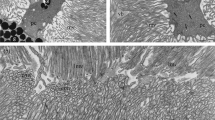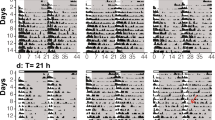Summary
-
1.
The circadian rhythm of spontaneous optic nerve impulses from the isolated eye ofAplysia californcía was studied. A general hypothesis was investigated: light-dark cycles, which can entrainin vitro the rhythm from the eye, couple to the intracellular clock mechanism through membrane depolarization. This hypothesis was tested by exposing isolated eyes for fixed durations of time to a depolarizing stimulus, namely, elevation of K +0 (hi-K pulses).
-
2.
Depending on the phase of the rhythm in at which the eyes were treated, hi-K pulses produced either advance or delay phase shifts in the rhythm. A phase response curve was thus generated for 107 mM k +0 pulses of 4 hr duration.
-
3.
If the duration of the hi-K pulse was varied, keeping the phase at which the pulse started constant, the magnitude of the phase shift varied in a linear manner with the duration of the pulse.
-
4.
To examine the involvement of transmitter and neurohormone release in the production of the phase shifts, eyes were exposed to hi-K pulses in the presence of a medium (high Mg++, low Ca++) which should inhibit such release. Since only slight differences were observed in the phase shifts produced by hi-K and by hi-K in the presence of high Mg++, low Ca++, transmitter and neurohormone release do not appear to be involved in phase shift production by hi-K. It is likely that membrane depolarization alone is responsible for the phase shifts.
Similar content being viewed by others
References
Abood, L. G.: Interrelationships between phosphates and calcium in bioelectric phenomena. Internat. Rev. Neurobiol.9, 223–261 (1966).
Arch, S.: Polypeptide secretion from the isolated parieto-visceral ganglion ofAplysia Californica. J. gen. Physiol.59, 47–59 (1972).
Audesirk, G.: Neuronal interactions in optic nerve impulse production inAplysia. Physiologist14, 105 (1971).
Austin, G., Yai, H., Sato, M.: Calcium ion effects onAplysia membrane potentials. In: Invertebrate nervous systems (C. A. G. Wiersma, ed.), p. 39–53. Chicago: Univ. of Chicago Press 1967.
Baker, P. F.: Recent experiments on the properties of the Na efflux from squid axons. J. gen. Physiol.51 (part 2), p. 172–179 (1968).
Baker, P. F., Connelly, C. M.: Some properties of the external activation site of the Na pump in crab nerve. J. Physiol. (Lond.)185, 270–297 (1966).
Berlind, A., Cooke, I. M.: The role of divalent cations in electrically excited release of a neurohormone from crab pericardial organs. Gen. comp. Endocrinol.17, 60–72 (1971).
Brink, F. Jr., Bronk, D. W., Larrabee, M. G.: Chemical excitation of nerve. Ann. N.Y. Acad. Sci.47, 457–485 (1946).
Carpenter, D. O., Alving, B. O.: A contribution of an electrogenic Na+ pump to membrane potential inAplysia neurons. J. gen. Physiol.52, 1–21 (1968).
Carpenter, D. O., Gunn, R.: The dependence of pacemaker discharge ofAplysia neurons upon Na+ and Ca++. J. cell. Physiol.75, 121–127 (1970).
Curtis, H. J., Cole, K. S.: Membrane resting and action potentials from the squid giant axon. J. cell. comp. Physiol.19, 135–144 (1942).
Engbaek, L.: The pharmacological actions of magnesium ions with particular reference to the neuromuscular and cardiovascular system. Pharmacol. Rev.4, 396–414 (1952).
Eskin, A.: Properties of theAplysia visual system:in vitro entrainment of the circadian rhythm and centrifugal regulation of the eye. Z. vergl. Physiol.74, 353–371 (1971).
Frankenhaeuser, B., Vallbo, A. B.: Accommodation in myelinated nerve fibers ofXenopus laevis as computed on the basis of valtage clamp data. Acta physiol. scand.63, 1–20 (1965).
Gorman, A. L. F., Marmor, M. F.: Contributions of the sodium pump and ionic gradients to the membrane potential of a molluscan neurone. J. Physiol. (Lond.)210, 897–917 (1970).
Harvey, A. A., MacIntosh, F. C.: Calcium and synaptic transmission in a sympathetic ganglion. J. Physiol. (Lond.)97, 408–416 (1940).
Hayes, F. R., Pelluet, D.: Inorganic constituents of molluscs. J. Mar. Biol. Ass. U. K.26, 580–589 (1947).
Hodgkin, A. L., Huxley, A. F.: The dual effect of membrane potential on sodium conductance in the giant axon ofLoligo. J. Physiol. (Lond.)116, 497–506 (1952).
Hodgkin, A. L., Keynes, R. D.: The potassium permeability of a giant nerve fibre. J. Physiol. (Lond.)128, 61–88 (1955).
Hoyle, G.: The effects of some common cations on neuromuscular transmission in insects. J. Physiol. (Lond.)127, 90–103 (1955).
Hughes, H. P. I.: A light and electron microscope study of some opistho-branch eyes. Z. Zellforsch.106, 79–98 (1970).
Jacklet, J. W.: Circadian rhythm of optic nerve impulses recorded in darkness from is-lated eye ofAplysia. Science164, 562–563 (1969a).
Jacklet, J. W.: Electrophysiological organization of the eye ofAplysia. J. gen. Physiol.53, 21–42 (1969b).
Jacklet, J. W.: Circadian rhythm in the activity of a population of coupled neurons. Fed. Proc.30, 551 (1971).
Jacklet, J. W., Alvarez, R., Bernstein, B.: Ultrastructure of the eye ofAplysia. J. Ultrastruct. Res.38, 246–261 (1972).
Jacklet, J. W., Geronimo, J.: Circadian rhythm population of interacting neurons. Science174, 299–302 (1971).
Katz, B., Miledi, R.: A study of synaptic transmission in the absence of nerve impulses. J. Physiol. (Lond.)192, 407–463 (1967).
Kerkut, G. A., Meech, R. W.: The effect of ions on the membrane potential of snail neurones. Comp. Biochem. Physiol.20, 411–429 (1967).
Kernan, R. P.: Cell K, Washington, D. C.: Butterworth, Inc. 1965.
Miledi, R., Slater, C. R.: The action of calcium on neuronal synapses in the squid. J. Physiol. (Lond.)184, 473–498 (1966).
Pavlidis, T.: Populations of interacting oscillators and circadian rhythms. J. theoret. Biol.22, 418–436 (1969).
Pittendrigh, C. S., Minis, D. H.: The entrainment of circadian oscillations by light and their role as photoperiodic clocks. Amer. Nat.93, 261–294 (1964).
Rall, T. W., Sattin, A.: Factors influencing the accumulation of cyclic AMP in brain tissue. Adv. Biochem. Psychopharm.3, 113–133 (1970).
Rubin, R. P.: The role of calcium in the release of neurotransmitter substances and hormones. Pharmacol. Rev.22, 389–428 (1970).
Ruch, T. C., Patton, H. D., Woodbury, J. W., Towe, A. L.: Neurophysiology (2 ed.). Philadelphia: W. B. Saunders Co. 1965.
Sato, M., Austin, G., Yai, H., Maruhashi, J.: The ionic permeability changes during acetylcholine-induced responses ofAplysia ganglion cells. J. gen. Physiol.51, 321–345 (1968).
Shimizu, H., Creveling, C. R., Daly, J. W.: Effect of membrane depolarization and biogenic amines on the formation of cyclic AMP in incubatied brain slices. Adv. Biochem. Psychopharm.3, 135–154 (1970).
Sjodin, R. A., Beauge, L. A.: Coupling and selectivity of sodium and potassium transport in squid giant axons. J. gen. Physiol.51 (Part 2), 152–161s (1968).
Strumwasser, F.: The demonstration and manipulation of a circadian rhythm in a single neuron, p. 442–462. In: Circadian clocks (J. Aschoff, ed.). Amsterdam: North-Holland Publ. Co. 1965.
Winfree, A. T.: Integrated view of resetting a circadian clock. J. theoret. Biol.28, 327–374 (1970).
Author information
Authors and Affiliations
Additional information
Dedicated to Professor Jürgen Aschoff on the occasion of his 60th birthday for the important role he has played in generating the current interest in circadian rhythm research.
I am very grateful to Dr. Felix Strumwasser for providing excellent facilities for this research and for helpful suggestions during the course of this work and the writing of this manuscript. I thank Mr. Dave Peisner for his assistance in performing preliminary experiments on the effects of hi-K pulses on the eye ofAplysia. I thank Mr. James Gilliam for his skillful technical assistance and Drs. S. Arch, D. L. Wilson, and Mr. J. Ram for helpful discussions. This work was supported in part by USPHS Postdoctoral Fellowships (1-F2-GM-33,240-01 and 2-F02-GM-32,240,02) and grants from NIH (NS 07071), NASA (NGR 05-002-031), and the Alfred P. Sloan Foundation to Dr. F. Strumwasser.
Rights and permissions
About this article
Cite this article
Eskin, A. Phase shifting a circadian rhythm in the eye ofAplysia by high potassium pulses. J. Comp. Physiol. 80, 353–376 (1972). https://doi.org/10.1007/BF00696434
Received:
Issue Date:
DOI: https://doi.org/10.1007/BF00696434




